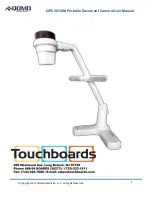
IL3 User’s Guide
11S-3002B
page 69
Application Note 5: Optimizing System for Image Transfers
Transferring large volumes of image data from the camera to a computer over the Gigabit Ethernet
connection can be very fast on an optimized system. For example, a full 8GB camera buffer will
produce about 25GB of color TIFF files. An optimized high-performance system may transfer 25GB of
full-resolution images from camera to PC in less than five minutes, while on an un-optimized system,
the transfer could easily take more than an hour.
Several parameters contribute to file transfer performance:
•
Network and PC hardware
•
PC activity
•
FasMotion setup
•
Image file format and resolution
Network and PC Hardware
•
Processor/Chipset type and speed: use fast multi-core processors, 64-bit system
•
Memory capacity and speed: 4GB minimum. 8GB recommended
•
Graphics card type speed and onboard memory: Graphics performance can throttle live and
playback views, graphics cards without onboard memory will take system memory and slow
things down
•
NIC type and speed: NIC performance varies widely. Pick a Gigabit NIC that supports Jumbo
Frames. We have found that some systems only perform well with Jumbo frames set to 9K,
while others work well at 1500. This is a parameter that you may need to experiment with to get
optimum results.
•
Multiple Network interfaces may be available on a given PC. For optimum transfers, for best
results you may wish to disable or disconnect all interfaces other than the one to be used with
the camera during transfers.
•
Hard Disk type: sustained transfer speed is most important drive attribute. Having a second drive
on the system for image transfers is helpful--avoid using the drive that the OS and any program
files are on. SATA II or III SSD or high-speed spinning media drives may be added internally or
externally to your PC. If the PC has an eSATA port, consider connecting an SSD to it for image
transfers.
•
Disk state: fragmented disks and disks that are running out of space will slow transfers.
PC OS/Software
•
Close all other applications, services, updaters, etc., including performance monitors such as
WindowsTask Manager, Wireshark, HD Tune Pro, etc. while running FasMotion.
•
File System format: On a Windows PC, use NTFS for the data drive.
•
Do not index the target drive.
•
PC Power Management: disable all, including sleep modes for PC and NIC
•
Disable all Firewalls and Anti-virus software! (You will not want the PC attached to the any outside
network including the Internet while connected to the camera.)
•
3rd party filter drivers: (disable using NIC’s properties page)
















































